E-Learning Financing Models in Russia for Sustainable Development
Abstract
1. Introduction
- foresighted thinking;
- interdisciplinary work;
- cosmopolitan perception;
- intercultural understanding and cooperation;
- participatory skills;
- planning and implementation;
- empathy, compassion and solidarity;
- self-motivation and motivating others;
- distanced reflection on individual and cultural models.
2. Methods
2.1. Research Design
2.2. Data Analysis
- Uralsib (financial corporation);
- Vimpelcom (second-largest cellphone company);
- Sibneft (oil producer);
- Severstal (mining company);
- Nornickel (mining and smelting company);
- Sberbank (banking services company);
- AvtoVAZ (automobile manufacturer).
- Russian State University for the Humanities;
- International Academy of Business and Financial Management;
- Moscow Witte University;
- Moscow State University of Geodesy and Cartography;
- Moscow Socio-Economic Institute;
- Moscow Power Engineering Institute;
- Moscow International University;
- Moscow Institute of Business and Design;
- Russian University of Cooperation;
- International Banking Institute;
- D.F. Ustinova Baltic State Technical University;
- Ufa State Oil Technical University;
- Omsk Law Academy;
- G.I. Nevelsky Maritime State University.
- The Distance Learning Center, Academy of National Economy under the Government of the Russian Federation;
- Moscow Business School;
- International Institute of Management ‘LINK’;
3. Results
- financing the learning process to achieve relevant core competencies;
- financing education for sustainable development with the purpose of socialization;
- financing individual training for personal growth.
4. Discussion
- (1)
- when forming the budget for financing educational institutions, the features of the functioning of individual educational institutions, their material base, and territorial location should be taken into account [65];
- (2)
- introducing a unified system for analysis of the use of budgetary and extra-budgetary funds by educational institutions [66];
- (3)
- legalization of the provision of modern services that contribute to the development of human capital and are often outside the legal field due to the inertia of the bureaucratic legislative process [67].
5. Conclusions
Author Contributions
Funding
Conflicts of Interest
References
- Barth, M.; Rieckmann, M. Academic staff development as a catalyst for cur-riculum change towards education for sustainable development: An output perspective. J. Clean. Prod. 2012, 26, 28–36. [Google Scholar] [CrossRef]
- Shurygin, V.Y.; Sabirova, F.M. Particularities of blended learning implementation in teaching physics by means of LMS Moodle. Rev. Espac. 2017, 38, 39. [Google Scholar]
- Grobon, S. How much do young adults cost their parents. In Household Income and Wealth; INSEE: Paris, France, 2018; pp. 65–80. [Google Scholar]
- Johnstone, D.B. Financing Higher Education: Worldwide Perspectives and Policy Options; The HEAD Foundation: Charlottesville, VA, USA, 2015. [Google Scholar]
- Martinho, A.P.; Bacelar-Nicolau, P.; Caeiro, S.; Amador, F.; Oliveira, C. Environmental citizenship and participation. The role of education programs. In Proceedings of the Knowledge Collaboration & Learning for Sustainable Innovation ERSCP-EMSU Conference, Delft, The Netherlands, 25–29 October 2010; pp. 1–17. [Google Scholar]
- Romanov, E.V. The phenomenon of tacit knowledge loss in high school: Causes and consequences Part 1. The Education and science journal. 2019, 21, 60–91, (In Russ.). [Google Scholar] [CrossRef]
- Azeiteiro, U.; Leal Filho, W.; Caeiro, S. E-learning and Education for Sustainability in the Series Umweltbildung, Umweltkommunikation und Nachhaltigkeit e Environmental Education, Communication and Sustainability; Peter Lang: Frankfurt, Germany, 2014; Volume 35. [Google Scholar]
- Bacelar-Nicolau, P.; Martinho, A.P.; Amador, F.; Caeiro, S.; Azeiteiro, U.M. 2On- line learning for sustainability: The student perception in an environmental science post-graduation. In Contributions to the UN Decade of Education for Sustainable Development; Gonçalves, F., Pereira, R., Leal Filho, W., Azeiteiro, U.M., Eds.; Peter Lang GmbH: Warsaw, Poland, 2012; pp. 281–294. [Google Scholar]
- Cruickshank, H.; Fenner, R. Exploring key sustainable development themes through learning activities. Int. J. Sustain. High. Educ. 2012, 13, 249–262. [Google Scholar] [CrossRef]
- Holden, M.; McIlhenney, K. Online Education in Sustainability Assessment Guide; British Columbia Institute of Technology: Vancouver, BC, Canada, 2010. [Google Scholar]
- Wiek, A.; Withycombe, L.; Redman, C.L. Key competencies in sustainability: A reference framework for academic program development. Sustain. Sci. 2011, 6, 2013–2218. [Google Scholar] [CrossRef]
- Diamond, S.; Irwin, B. Using e-learning for student sustainability literacy: Framework and review. Int. J. Sustain. High. Educ. 2013, 14, 338–348. [Google Scholar] [CrossRef]
- Disterherft, A.; Leal Filho, W.; Azeiteiro, U.; Caeiro, S. Sustainability science and education for sustainable development in universities: A critical reflection. In Sustainability Assessment Tools in Higher Education Institutions. Mapping Trends and Good Practices at Universities Round the World; Caeiro, S., Leal Filho, W., Charbel, J., Azeiteiro, U., Eds.; Springer International Publishing: Basel, Switzerland, 2013; pp. 3–27. [Google Scholar]
- Aggarwal, V. E-Learning for Skill Training: Applications and Best Practices for the Public Sector; National Skill Development Corporation: New Delhi, India, 2017. [Google Scholar]
- Alexe, C.G.; Alexe, C.M. E-Learning-Facilitator Tool for the Development of Technological Entrepreneurship. eLearn. Softw. Educ. 2019, 2, 177–183. [Google Scholar]
- Catana, A.; Manea, D.; Titan, E. The contribution of the e-learning projects to the quality of life in four regions for development during the programming period 2007–2013, Romania. In Proceedings of the International Scientific Conference eLearning and Software for Education, “Carol I” National Defence University, Bucharest, Romania, 23–24 April 2017; Volume 1, p. 351. [Google Scholar]
- Chipere, N. A framework for developing sustainable e-learning programmes. Open Learn. J. Open Distance eLearn. 2017, 32, 36–55. [Google Scholar] [CrossRef]
- Khoman, S. The Financing of Thai Education. In Education in Thailand; Springer: Singapore, 2018; pp. 579–596. [Google Scholar]
- Stepanyan, K.; Littlejohn, A.; Margaryan, A. Sustainable e-learning: Toward a coherent body of knowledge. J. Educ. Techno. Soc. 2013, 16, 91–102. [Google Scholar]
- Tarus, J.K.; Gichoya, D.; Muumbo, A. Challenges of implementing e-learning in Kenya: A case of Kenyan public universities. Int. Rev. Res. Open Distrib. Learn. 2015, 16, 120–141. [Google Scholar] [CrossRef]
- Ziderman, A.; Albrecht, D. Financing Universities in Developing Countries; Routledge: Abingdon-on-Thames, UK, 2013. [Google Scholar]
- De Freitas, S.; Oliver, M. Does E-learning Policy Drive Change in Higher Education? A case study relating models of organisational change to e-learning implementation. J. High. Educ. Policy Manag. 2005, 27, 81–96. [Google Scholar] [CrossRef]
- Fletcher, M.; Grainger, P. Future of Work and Education for the Digital Age: Evaluating Options for Funding and Financing Post-Compulsory Education; Consejo Argentino Para Las Relaciones Internacionales: Buenis Aires, Argentina, 2019. [Google Scholar]
- Zubanova, S.; Bodrova, T.; Kruchkovich, S. Evaluaciones: Metodología e indicadores de calidad. Relig. Rev. Cienc. Soc. Humanid. 2019, 4, 277–281. [Google Scholar]
- Huynh, M.Q.; Umesh, U.N.; Valacich, J.S. E-learning as an emerging entrepreneurial enterprise in universities and firms. Commun. Assoc. Inf. Syst. 2003, 12, 47–69. [Google Scholar] [CrossRef]
- Johnstone, D.B.; Marcucci, P.N. Financing Higher Education Worldwide: Who pays? Who should pay? JHU Press: Baltimore, MD, USA, 2010. [Google Scholar]
- Moore, M. Three types of interactions. Am. J. Distance Educ. 1989, 3, 1–7. [Google Scholar]
- Moura, A.P.M.; Cunha, L.M.; Azeiteiro, U.M.; Aires, L.; de Almeida, M.D.V. Food consumer science post-graduate courses: Comparison of face-to-face versus on- line delivery systems. Br. Food J. 2010, 112, 544–556. [Google Scholar] [CrossRef]
- Oliveira, C.P.; Martinho, A.P.; Caeiro, S.; Amador, F.; Caetano, F. Field activities within an undergraduate program of environmental sciences: A b-learning case study. In Contributions to Sustainability in the Series Umweltbildung, Umweltkommunikation und Nachhaltigkeit e Environmental Education, Communication and Sustainability; Gonçalves, F., Pereira, R., Leal Filho, W., Azeiteiro, U.M., Eds.; Peter Lang: Bern, Switzerland, 2012; p. 255. [Google Scholar]
- European University Association. Public Funding Observatory Report 2017; European University Association: Brussel, Belgium, 2017. [Google Scholar]
- Saadatian, O.; Salleh, E.; Osman Mohd Tahir, O.; Dola, K. Observations of sustainability practices in Malaysian research universities: Highlighting particular strengths. Pertanika J. Soc. Sci. Humanit. 2012, 17, 225–244. [Google Scholar]
- Saadatian, O.; Sopian, K.B.; Salleh, E. Adaptation of sustainability community indicators for Malaysian campuses as small cities. Sustain. Cities Soc. 2013, 6, 40–50. [Google Scholar] [CrossRef]
- Levina, E.Y.; Masalimova, A.R.; Kryukova, N.I.; Grebennikov, V.V.; Marchuk, N.N.; Shirev, D.A.; Renglikh, K.A.; Shagieva, R.V. Structure and content of e-learning information environment based on geo-information technologies. Eurasia J. Math. Sci. Tech. Ed. 2017, 13, 5019–5031. [Google Scholar] [CrossRef]
- Yanuschik, O.V.; Pakhomova, E.G.; Batbold, K. E-learning as a Way to Improve the Quality of Educational for International Students. Procedia Soc. Behav. Sci. 2015, 215, 147–155. [Google Scholar] [CrossRef]
- Ilyina, E.A.; Shchiptsova, A.V.; Poverinov, I.E.; Grigoreva, S.V.; Gorshkova, N.K.; Fisunov, P.A.; Work, M. Features of the Development of the Digital Educational Environment in Russia. Int. J. High. Educ. 2019, 8, 121–131. [Google Scholar] [CrossRef]
- Vodenko, K.V. Problems and perspectives of state regulation of system of education in the context of provision of Russia’s national security. Int. J. Educ. Manag. 2019, 33, 462–469. [Google Scholar] [CrossRef]
- Zeer, E.F.; Tretyakova, V.S.; Miroshnichenko, V.I. Strategic Directions of Pedagogical Personnel Training for the System of Continuing Vocational Education. Educ. Sci. J. 2019, 21, 93–121. (In Russian) [Google Scholar] [CrossRef]
- Lozano, R.; Lukman, R.; Lozano, F.; Huisingh, D. Declarations for sustain- ability in higher education becoming better leaders, through addressing the university system. J. Clean. Prod. 2013, 48, 10–19. [Google Scholar] [CrossRef]
- Lozano, R.; Young, W. Assessing sustainability in university curricula: Exploring the influence of student numbers and course credits. J. Clean. Prod. 2013, 49, 134–141. [Google Scholar] [CrossRef]
- Digital Economy: New Reality. Available online: https://www.mckinsey.com/~/media/McKinsey/Locations/Europe%20and%20Middle%20East/Russia/Our%20Insights/Digital%20Russia/Digital-Russia-report.ashx (accessed on 15 February 2020).
- Varlamov, B.A.; Avvakumova, A.D. Analysis of approaches to the financing of the education system abroad. Fundam. Res. 2015, 6, 99–102. [Google Scholar]
- Altbach, F.J. Massivization of Higher Education and the Global Economics of Knowledge: Lingering Contradictions. Int. J. High. Educ. 2015, 80, 9. [Google Scholar]
- Anikina, E.A.; Ivankina, L.I.; Sorokina, Y.S. Higher education crisis in Russia: Manifestations, causes and consequences. Modern problems of science and education 2016, 3. Available online: https://www.science-education.ru/ru/article/view?id=24770 (accessed on 15 February 2020).
- Mayorova, T.V. Problems of financing higher education in the context of globalization. Available online: https://cyberleninka.ru/article/n/problemy-finansirovaniya-vysshego-obrazovaniya-v-usloviyah-globalizatsii (accessed on 15 February 2020).
- Argumenty i Fakty. Distance Learning: Specificity of Electronic Education Technologies. Available online: https://aif.ru/boostbook/distantsionnoe-obuchenie.html (accessed on 15 February 2020).
- EdMarket Research. Exploring Russian Market of Online Education and Educational Technologies. Available online: https://edumarket.digital/en/?redirect=no (accessed on 15 February 2020).
- Lapchik, M.P. Developing the regulatory framework for distance education in Russia. RUDN J. Informatiz. Educ. 2014, 4, 100–113. [Google Scholar]
- Karatzoglou, B. An in-depth literature review of the evolving roles and contributions of universities to education for sustainable Development. J. Clean. Prod. 2013, 49, 44–53. [Google Scholar] [CrossRef]
- Lambrechts, W.; Mulà, I.; Ceulemans, K.; Molderez, I. The integration of competences for sustainable development in higher education: An analysis of bachelor programs in management. J. Clean. Prod. 2013, 48, 65–73. [Google Scholar] [CrossRef]
- Mochizuki, Y.; Fadeeva, Z. Competences for sustainable development and sustainability: Significance and challenges for ESD. Int. J. Sustain. High. Educ. 2010, 11, 391–403. [Google Scholar] [CrossRef]
- Palmer, S.; Holt, D. Students’ perceptions of the value of the elements of an online learning environment: An investigation of discipline differences. In Proceedings of the World Academy of Science, Engineering and Technology, Istanbul, Turkey, 20 January 2010; Volume 66, pp. 1399–1406. [Google Scholar]
- Sibbel, A. An experience in developing and implementing blended learning for sustainability. In E-Learning and Sustainability in the Series Umweltbildung, Umweltkommunikation und Nachhaltigkeit-Environmental Education, Communication and Sustainability; Azeiteiro, U., Leal Filho, W., Caeiro, S., Eds.; Peter Lang: Bern, Switzerland, 2014; Volume 35, p. 15. [Google Scholar]
- Fadeeva, Z.; Mochizuki, Y. Higher education for today and tomorrow: University appraisal for diversity, innovation and change towards sustainable development. Sustain. Sci. 2010, 5, 249–256. [Google Scholar] [CrossRef]
- Paechter, M.; Maier, B.; Macher, D. Students’ expectations of and experiences in e-learning: Their relation to learning achievements and course satisfaction. Comput. Educ. 2010, 54, 222–229. [Google Scholar] [CrossRef]
- Nazartseva, E.A.; Morya, L.A.; Zubanova, S.G. Teaching foreign students the vocation-related language. Amazon. Investig. 2019, 8, 338–343. [Google Scholar]
- Wilson, G.; Abbott, D.; De Kraker, J.; Pe´rez, S.; Terwisscha Van Scheltinga, C.; Willems, P. The lived experience of climate change: Creating open educational resources and virtual mobility for an innovative, integrative and competence-based track at Masters level. Int. J. Technol. Enhanc. Learn. 2011, 3, 111–123. [Google Scholar] [CrossRef]
- Zsóka, Á.; Szere´nyi, Z.M.; Sze´chy, A.; Kocsis, T. Greening due to environmental education? Environmental knowledge, attitudes, consumer behaviour and everyday pro-environmental activities of Hungarian high school and university students. J. Clean. Prod. 2013, 48, 126–138. [Google Scholar] [CrossRef]
- Bacelar-Nicolau, P.; Caeiro, S.; Martinho, A.; Azeiteiro, U.M.; Amador, F. E- Learning for the environment. The universidade aberta (Portuguese open dis- tance university) experience in the environmental sciences Post-Graduate courses. Int. J. Sustain. High. Educ. 2009, 10, 354–367. [Google Scholar] [CrossRef]
- Borck, R.; Wimbersky, M. Political economics of higher education finance. Oxf. Econ. Pap. 2014, 66, 115–139. [Google Scholar] [CrossRef][Green Version]
- Martinho, A.P.; Caeiro, S.; Caetano, F.; Azeiteiro, U.; Bacelar-Nicolau, P. Training and Employability, competences from an e-learning undergraduate programme in environmental Sciences. In E- Learning and Sustainability in the Series Umweltbildung, Umweltkommunikation und Nachhaltigkeit e Environmental Education, Communication and Sustainability; Azeiteiro, U., Leal Filho, W., Caeiro, S., Eds.; Peter Lang: Bern, Switzerland, 2014; Volume 35. [Google Scholar]
- Tokareva, E.A.; Malysheva, O.G.; Smirnova, Y.V. Prospects of the liberal arts educational model in the national history study. Opcion. 2019, 35, 11–29. [Google Scholar]
- Rieckmann, M. Future-oriented higher education: Which key competencies should be fostered through university teaching and learning? Futures 2012, 44, 127–135. [Google Scholar] [CrossRef]
- Goryainova, L.V.; Krishtal, I.S.; Kuznetsova, O.D. Financing of infrastructure in education: International experience of attracting private investments and opportunities for Russia to form a knowledge-driven economy. Eur. Res. Stud. 2017, 20, 348–363. [Google Scholar]
- Yokogawa, K. Public Service Provision and Its Finance in Russia: The Case of Education. J. Comp. Econ. Stud. 2017, 12, 101–120. [Google Scholar]
- Abankina, I.; Filatova, L.; Nikolayenko, E. Polarization of universities in the Central Federal District of Russia under reform. J. Appl. Res. High. Educ. 2018, 10, 410–429. [Google Scholar] [CrossRef]
- Taranov, P.V.; Basenko, A.M.; Roshchina, L.N.; Kulikova, I.V.; Israilova, E.A.; Samygin, S.I. Crisis of the education system in Russia under the world economic crisis. MJLTM 2018, 8, 241–247. [Google Scholar]
- Kuchumov, A.; Terentiev, S.; Gnezdova, J. Strategic Initiatives of Education Development in Russia in the Conditions of Development of Digital Technologies. In Proceedings of the 3rd International Conference on Culture, Education and Economic Development of Modern Society (ICCESE), Moscow, Russia, 1–2 March 2019; Atlantis Press: Paris, France, 2019. [Google Scholar]
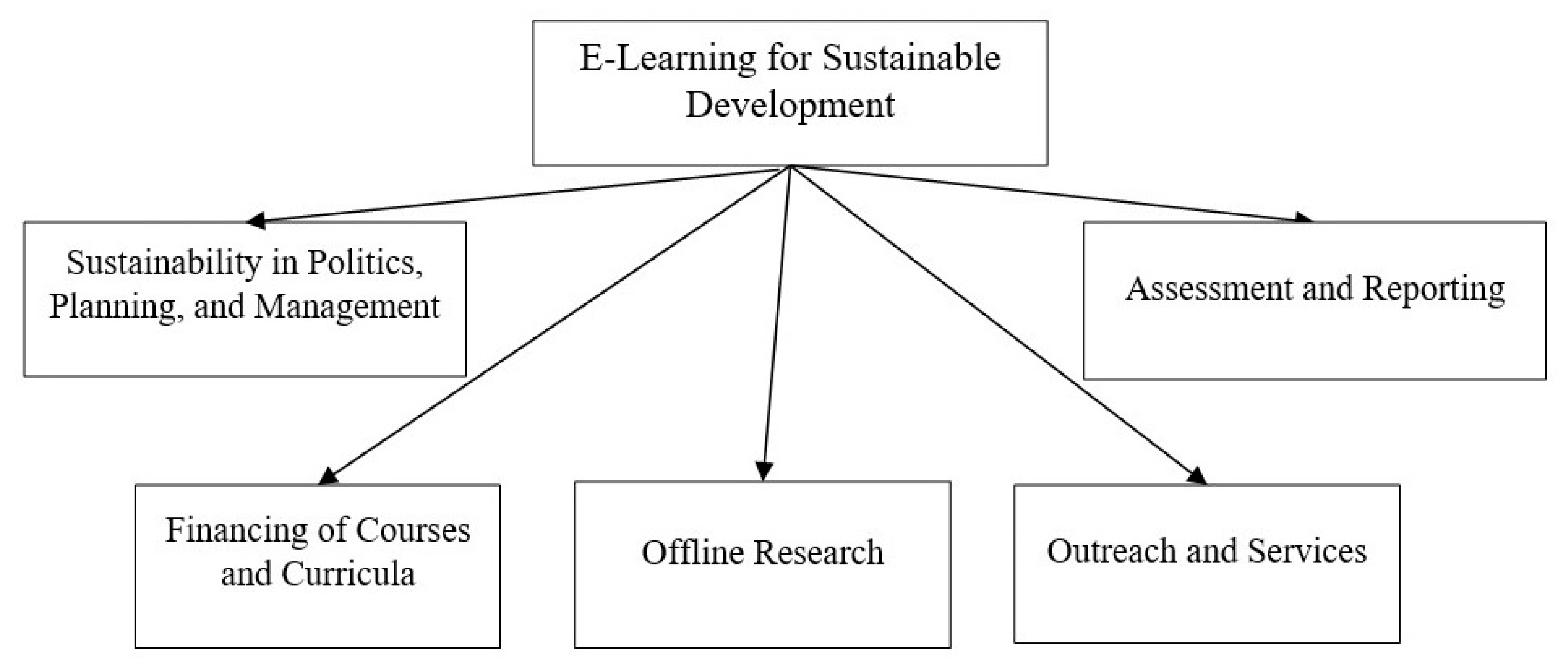
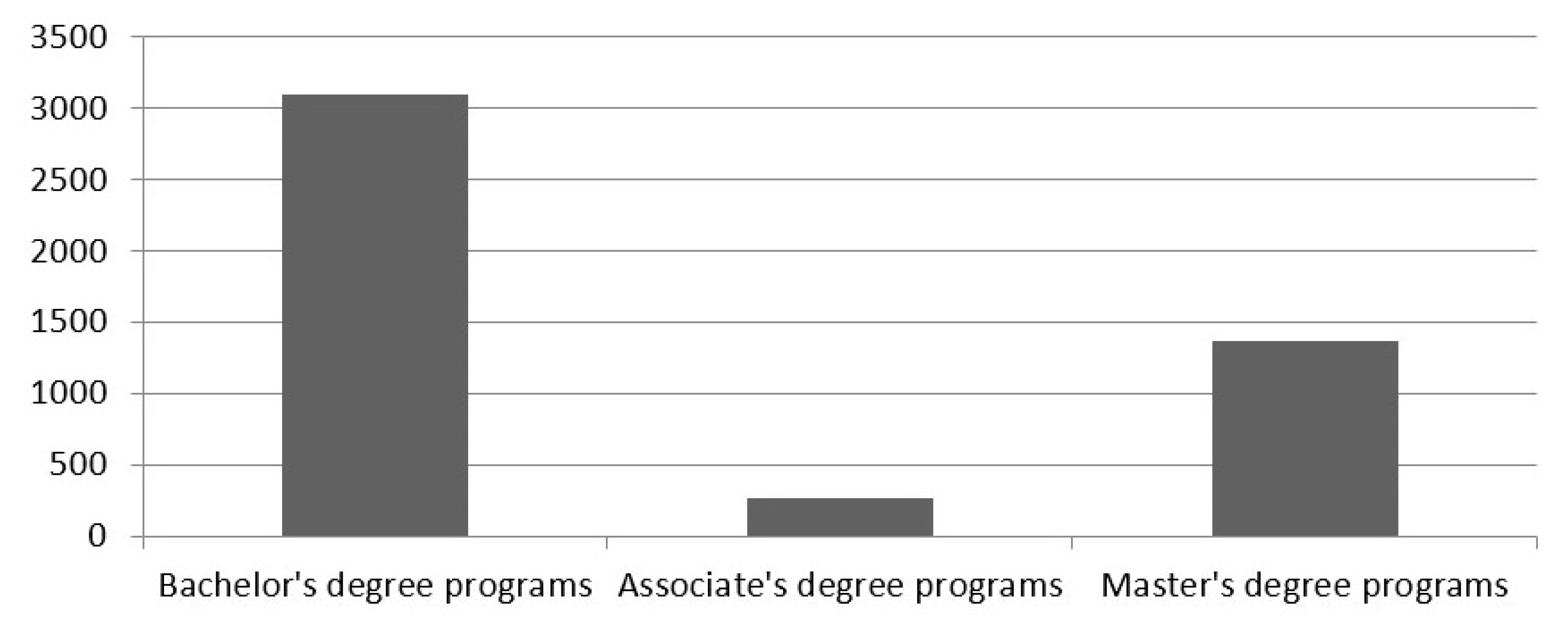

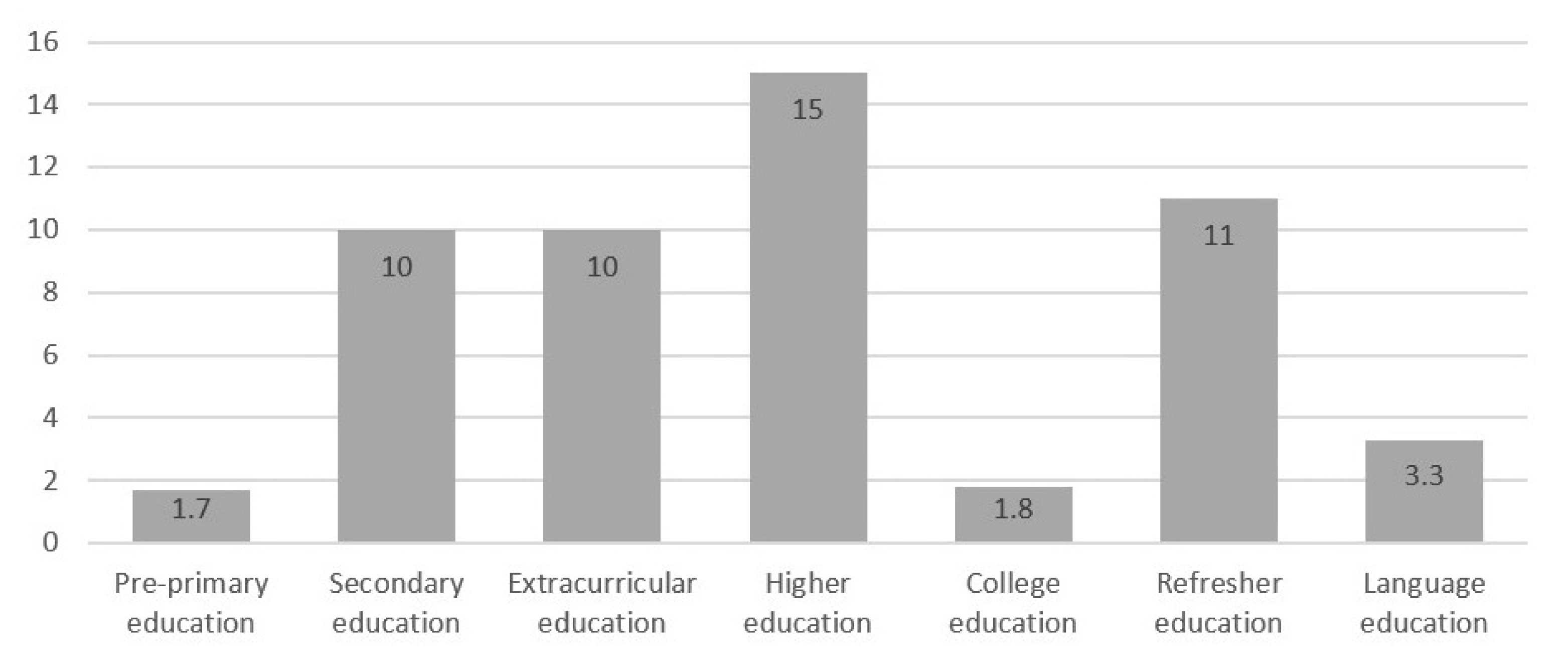
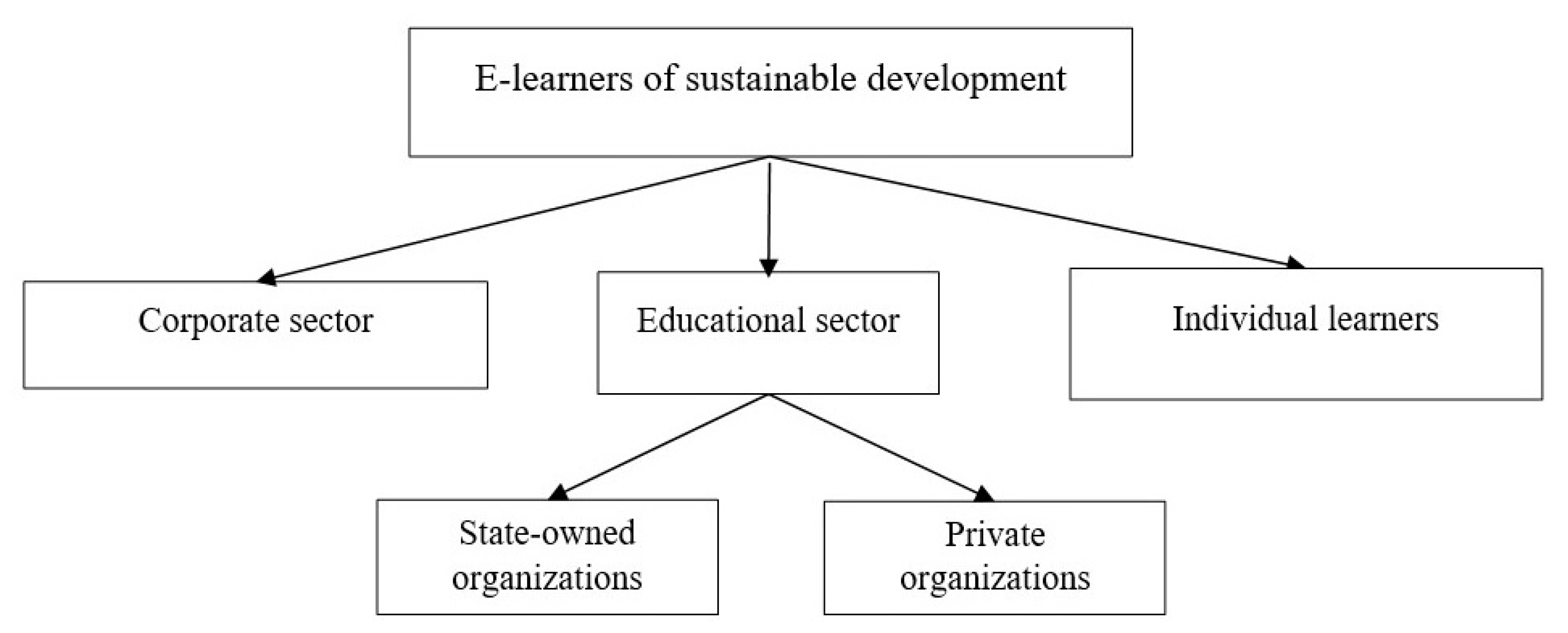
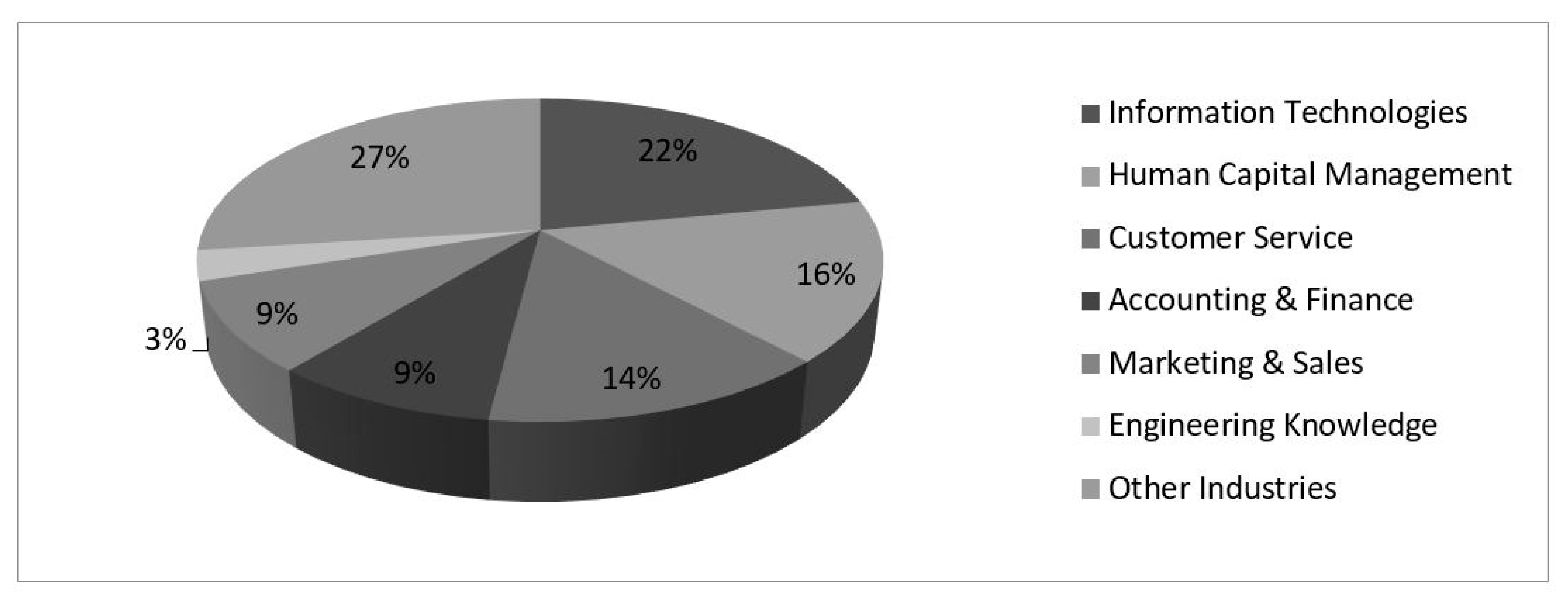

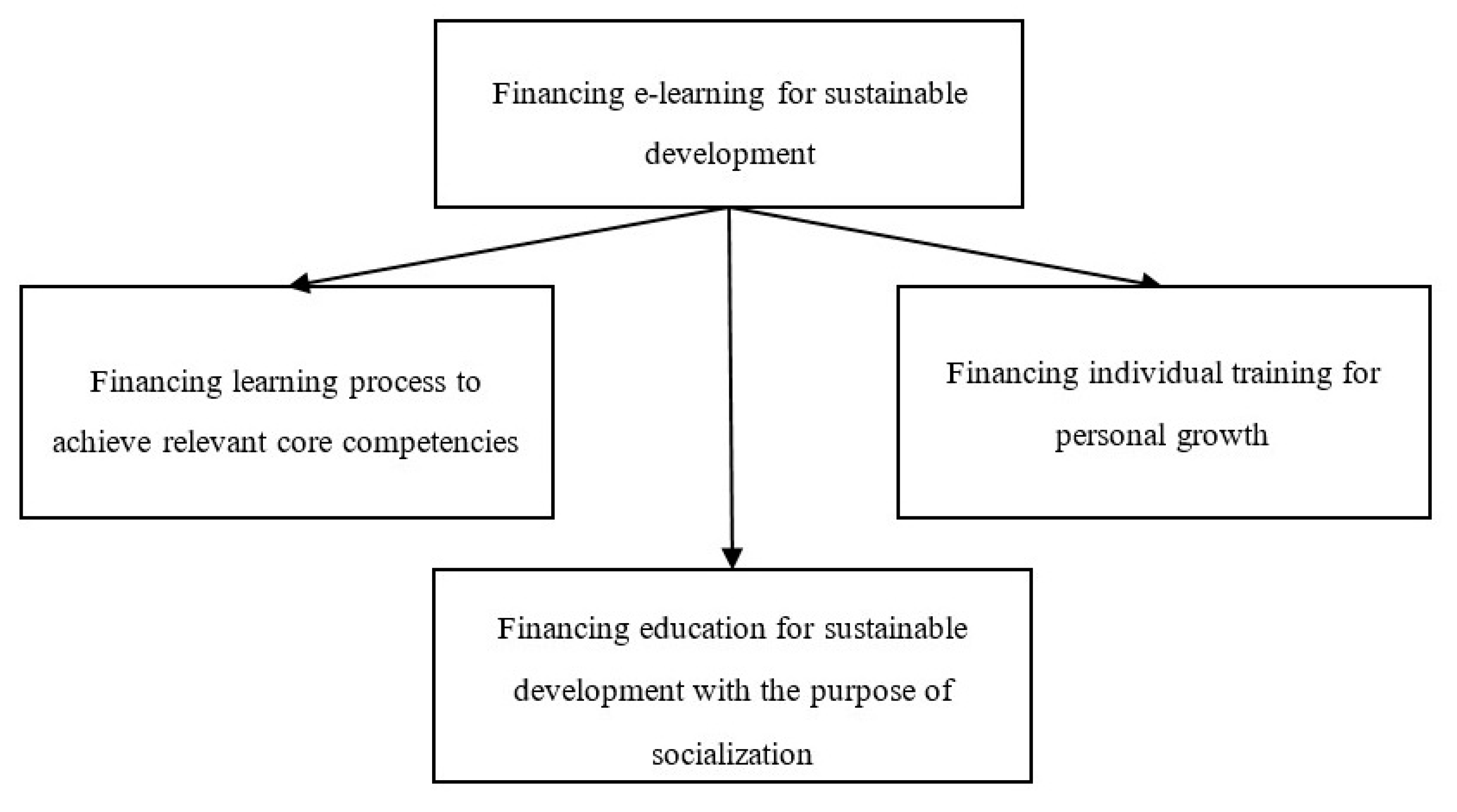
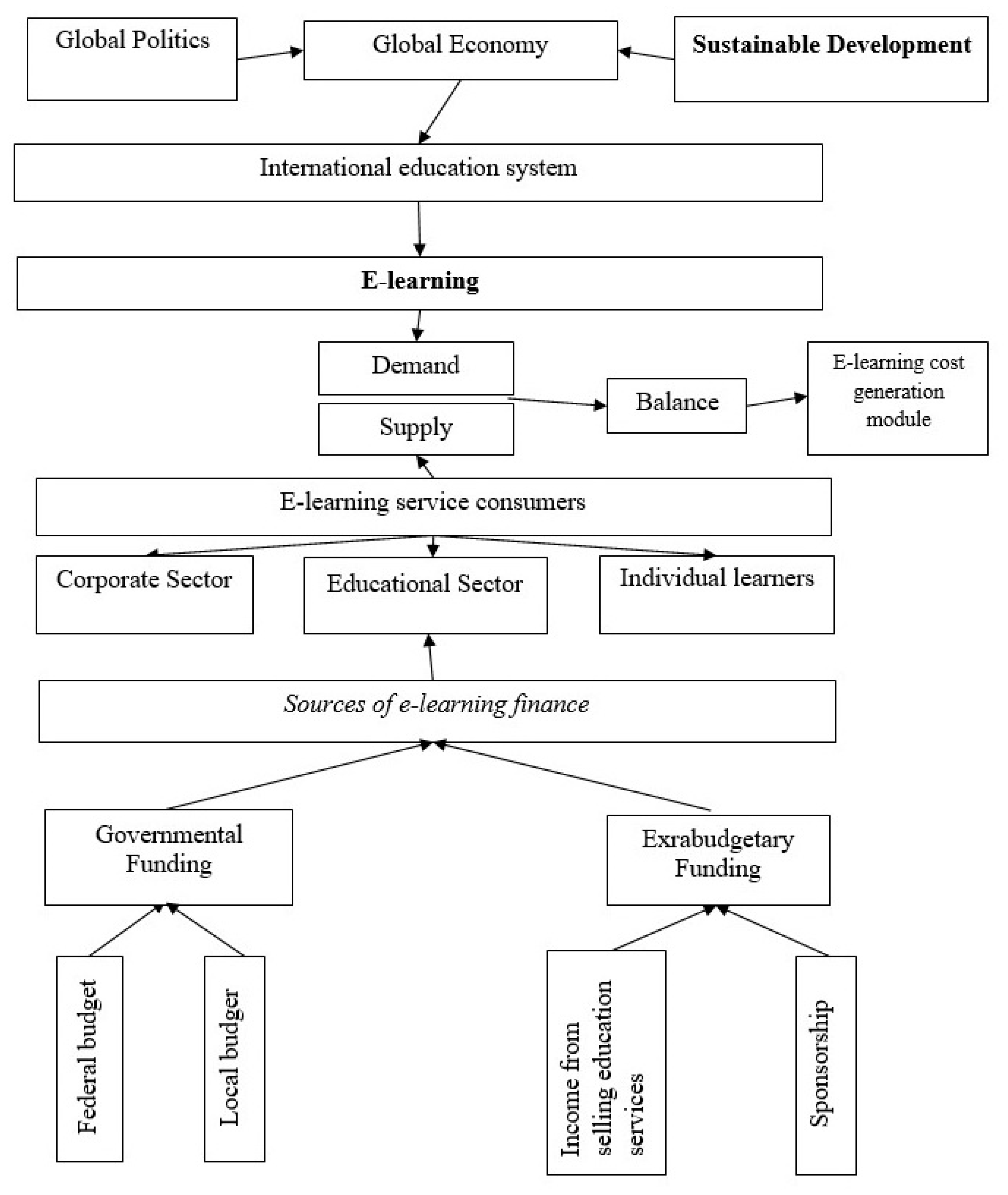
| Model | Description | Aim |
|---|---|---|
| Free Market | Being in the market improves the quality of education owing to available mechanisms the market offers to control the education system. Among these are personnel training and mechanisms to accelerate the growth of profit of educational institutions. The government retains its control function but its role is reduced with the reduction of education spending. | Equal opportunities to all |
| Social Market | Partnership between the government and private companies stimulates intense and productive activity owing to increasing private investments and the reduction of governmental funding. This model promotes e-learning development through privatization. | Outreach towards middle class learners; Social tension relief;Social and education-related problem solving |
| Anti-Market | E-learning is financed from the government (i.e., tax revenue from non-educational organizations). This model suggests an increase of employees. | Education quality improvement via feedback analysis |
© 2020 by the authors. Licensee MDPI, Basel, Switzerland. This article is an open access article distributed under the terms and conditions of the Creative Commons Attribution (CC BY) license (http://creativecommons.org/licenses/by/4.0/).
Share and Cite
Nie, D.; Panfilova, E.; Samusenkov, V.; Mikhaylov, A. E-Learning Financing Models in Russia for Sustainable Development. Sustainability 2020, 12, 4412. https://doi.org/10.3390/su12114412
Nie D, Panfilova E, Samusenkov V, Mikhaylov A. E-Learning Financing Models in Russia for Sustainable Development. Sustainability. 2020; 12(11):4412. https://doi.org/10.3390/su12114412
Chicago/Turabian StyleNie, Dayong, Elena Panfilova, Vadim Samusenkov, and Alexey Mikhaylov. 2020. "E-Learning Financing Models in Russia for Sustainable Development" Sustainability 12, no. 11: 4412. https://doi.org/10.3390/su12114412
APA StyleNie, D., Panfilova, E., Samusenkov, V., & Mikhaylov, A. (2020). E-Learning Financing Models in Russia for Sustainable Development. Sustainability, 12(11), 4412. https://doi.org/10.3390/su12114412






